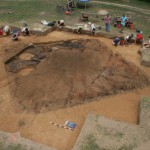- Uncovering history: Near Morganton, archaeologists recently discovered the location of what could be the earliest European fort in the North American interior. photos courtesy of the University of Michigan
- A-Team: Archaeologists Rob Beck, David Moore, and Chris Rodning led the effort, assisted by students from Warren Wilson College.
After years of excavations, archaeologists are confident they've discovered the location of the earliest European fort in the North American interior at a Western North Carolina site near Morganton, shedding light on the complicated relationship between colonizers and native peoples.
David Moore, a Warren Wilson College professor and director of a field school at the site, is one of several archaeologists whose work led to the revelation.
"Our work at the Berry site helps us to learn more about the early and critical period of interaction between the native peoples and European colonizers," says Moore, who's been assisted over the years by teams of Warren Wilson students. "It’s a complex and compelling story that foretells the troubles and tragedies faced by Native Americans over the next several centuries. At the same time, it is a story of native resilience, a story that also reflects the position of native peoples today.”
Spanish Captain Juan Pardo and his men built Fort San Juan in the foothills of the Appalachian Mountains in 1567, nearly 20 years before Sir Walter Raleigh’s “lost colony” at Roanoke Island and 40 years before the Jamestown settlement established England’s presence in the region, according to a press release from the University of Michigan, who's faculty was also instrumental in the findings.
“Fort San Juan and six others that together stretched from coastal South Carolina into eastern Tennessee were occupied for less than 18 months before the Native Americans destroyed them, killing all but one of the Spanish soldiers who manned the garrisons,” explains Michigan archaeologist Robin Beck.
The site is located along a tributary of the Catawba River and was built in the Native American town of Joara, part of the mound-building Mississippian culture that flourished in the Southeast between 800 and about 1500 CE.
In 2004, with support from the National Geographic Society and the National Science Foundation, the team of archeologists began excavating several of the houses occupied by Spanish soldiers at Joara, where Pardo built the fort. Yet the remains of the structure itself eluded discovery until last month. “We have known for more than a decade where the Spanish soldiers were living,” says Christopher Rodning of Tulane University. “This summer we were trying to learn more about the Mississippian mound at Berry, one that was built by the people of Joara, and instead we discovered part of the fort. For all of us, it was an incredible moment.”
Using a combination of large-scale excavations and geophysical techniques like magnetometry, which provides X-ray-like images of what lies below the surface, the archaeologists have now been able to identify sections of the fort’s defensive moat or ditch, a likely corner bastion and an entryway to the garrison. Excavations in the moat conducted in late June reveal it to have been a large V-shaped feature measuring 5.5 feet deep and 15 feet across. Artifacts recovered this summer include iron nails and tacks, Spanish majolica pottery and a type of iron clothing hook used for fastening doublets and attaching sword scabbards to belts.
Fort San Juan was the first and largest of the garrisons that Pardo founded as part of an ambitious effort to colonize the American South. Of the six garrisons that Pardo built, the fort is the only one to have been discovered by archaeologists.
During their brief time at Joara, Beck notes, the Spaniards were actively prospecting for gold but never found any. Yet the gold was there: In the early 1800s, American settlers found an abundance of it lying on the surface near rivers. In fact, there was so much of the precious metal that a 17-pound nugget was used as a doorstop and a federal mint was established in Charlotte, triggering the first gold rush in U.S. history.
Had the people of Joara given Pardo’s soldiers more time to discover this gold, Spain would probably have launched a full-scale colonial invasion of the area, England would have had difficulty establishing its foothold at Jamestown and the entire Southeast might instead have become part of Latin America, researchers speculate.
Why did the native Mississipians wipe the Spaniards out so quickly? Beck and his colleagues argue that it probably had to do with “food and sex.”
“The soldiers believed that when their gifts were accepted, it meant that the native people were their subjects,” says Beck. “But to the natives, it was simply an exchange. When the soldiers ran out of gifts, they expected the natives to keep on feeding them. By that time, they had also committed what Spanish documents refer to as ‘indiscretions’ with native women, which may have been another reason that native men decided they had to go.”
"The significance of Fort San Juan extends far beyond the Carolina Piedmont," adds Moore. "The events at Fort San Juan represent a microcosm of the colonial experience across the continent. Spain’s failure created an opening that England exploited at Jamestown in 1607, when America’s familiar frontier narrative begins.
“For Native Americans, though, this was the beginning of a long-term and often tragic reshaping of their precolonial world."
— Jake Frankel can be reached at 251-1333, ext. 115, or at jfrankel@mountainx.com.






Spaniards couldn’t hold Florida, so I wonder if they would have held this area against the English.
Congratulations to David Moore for his part in this discovery. I expect he knows this area as well as any other archaeologist.